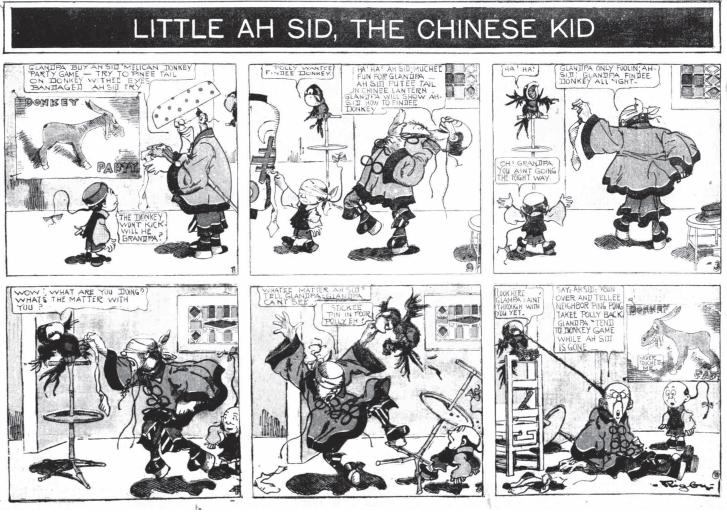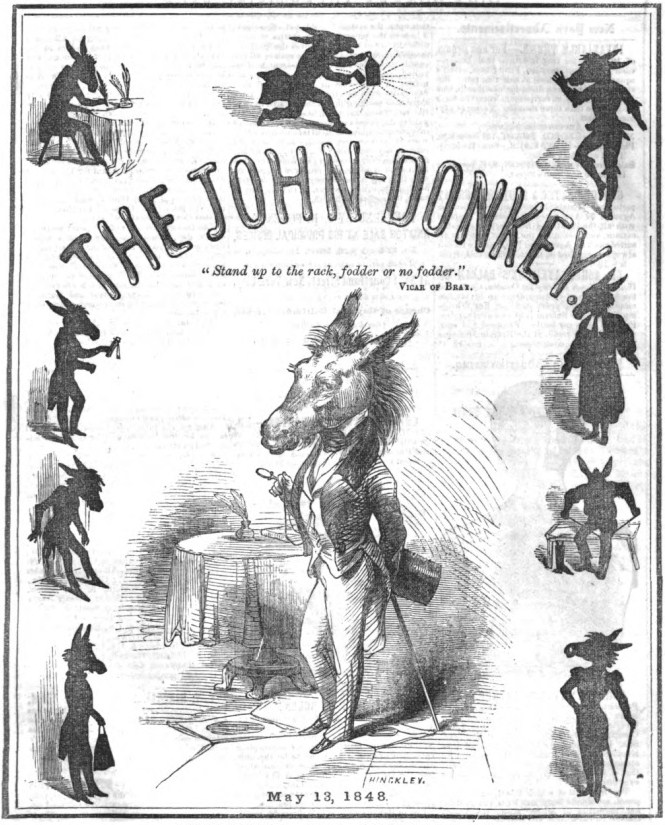Donkey Parties and Cheeseheads –
Pinning Down the Pointed History of “Pin the Tail on the Donkey”
Pop-culture images of children’s
birthday parties often depict fresh-faced kids playing “Pin the Tail on the
Donkey.” This Norman Rockwellesque
painting (1940s?):
. . . and this Leave-it-to-Beaverish, black-and-white
snapshot (1950s or early 1960s?):
. . . are typical.
But the game is much older. This early (and decidedly politically
incorrect) comic strip, for example, shows a “Donkey Party” in 1906:
Although it was probably a
coincidence (if not divine inspiration), the “cheesehead” on the grandfather’s
head in the first panel (perhaps the first cheesehead in recorded history) hints at the geographic
origins of the game:
Only beer and brats would have been more suggestive.
“Pin the tail
on the donkey” was invented, you see, in . . .
(wait for it)
. . . Milwaukee!
The Donkey Party Craze of ‘87:
A “donkey party” craze swept
across the United States in 1887. I have
not been able to pin-the-tail on precisely when the craze started, but it
reached the centers of culture and power, New York City and Washington DC, in
late 1886. The earliest reports credit
(or blame) Milwaukee for starting the fad:
Donkey parties are the latest
thing in the way of a social gathering in Milwaukee. A large silhouette representing a tailless
donkey is cut out of paper or cloth and fastened upon the wall. To each of the guests are given a cambric
tail and a pin. Then they are
blindfolded, one by one, placed in a corner opposite the donkey, are whirled
three times around, and then started on a blind search for the donkey, upon
which, if they reach it, the tail is to be pinned. If the guest goes in another direction and
stumbles against a wall, door, chair, or anything else, there he must leave the
tail. The movements of the blindfolded
are apt to be ludicrous. The person who makes
the best effort to place the tail upon the donkey where it belongs receives a
present of some kind, while the guest who makes the most unsuccessful effort
gets the booby prize.
The Sun (New York), December 27, 1886, page 2 (the article also
appeared .
Donkey parties are the latest
thing in a social way in Milwaukee. It
may appear strange to the observant reader, but these parties may be successful
without the presence of dudes.[i]
The Washington Critic, December 28, 1886, page 2.
The following weeks and months
brought dozens of accounts and descriptions of the hilarious new game. Women’s clubs, society dinners, men’s
smokers, charity events – everyone who was anybody hosted a “Donkey Party”:
The
Donkey Parties.
Jefferson City, Jan. 28.
Editor Bazoo: The very latest
social wrinkle that is convulsing capitol society, is the “Donkey
parties.” Everybody, “that is anybody,”
is trying that dexterous feat of “tailing the donkey.” Unless one has tried
that adroit deed, you have no conception how much mental and physical strain is
required. I have seen grave dignitaries
and wily Representatives waltz confidently up to the donkey and miss him by ten
feet. Senator Jacobs came very near
attaching the caudal appendage to the neck, and Speaker pro tem Russell left
the rear attachment on the off hoof.
Senator Gears the jolliest man in the senate, is contemplating giving a
“Donkey party” in the basement of the capitol, to “donkeys” only of the two
foot tribe, and demonstrate practically that no blinded man can successfully
accomplish the act in one trial, only.
The Sedalia Weekly Bazoo (Sedalia, Missouri), February 1, 1887,
page 5.
A variation of the “donkey party” also
included a contest for creating the best donkey cut-out with manila papers and
scissors:
The competition is very
entertaining, if not, at times, exciting, and the result most ludicrous. Any young dude who has studied up the anatomy
of the donkey over night and given his whole mind to the undertaking can
readily capture the first prize.
The Abbeville Press and Banner (Abbeville, South Carolina),
November 30, 1887, page 3.
Almost immediately, Charles Zimmerling was able to capitalize on the craze. Advertisements that he placed in the American Stationer magazine in 1888, claim that he received a copyright on a paper version of the game in 1887:
That magazine, which was devoted to the paper industry, hyped the craze in hopes of selling more paper donkeys, and "an unlimited supply of tails":
Although the article suggests that Zimmerling was the inventor of the game, the earliest reports place the game in Milwaukee in 1886. Charles Zimmerling lived in Philadelphia, Pennsylvania. However, since the 1880 census lists an Augustus Zimmerling, living in Milwaukee, Wisconsin, perhaps there is a Milwaukee connection, after all.
Both Augustus and Charles Zimmerling received utility patents during the 1880s. Augustus received a patent for a gas furnace, and Charles earned patents for soap, a cleaning compound for floors, and stove polish. Both Zimmerlings were born in Germany. Perhaps they were brothers? Perhaps Charles had a jump on the competition by learning about the game from his brother in Milwaukee? Perhaps Augustus introduced the game to Milwaukee after his brother invented the game in Philadelphia? We may never know.
Despite the hype, some people considered the “donkey party” old-fashioned, as early as November 1887:[ii]
That magazine, which was devoted to the paper industry, hyped the craze in hopes of selling more paper donkeys, and "an unlimited supply of tails":
Donkey parties are going to be
still more numerous during the coming season, and besides the usual
participants will require the faithful representation of “Asinus” and, what is
equally important, an unlimited supply of tails. Many crude and ill formed resemblances of the
donkey have been made to serve the purpose of having some fun. It is much better to procure a properly drawn
donkey and all of his needed appendages.
The inventor of this game is C. Zimmerling, of Philadelphia, and he has
published a sheet on which the donkey and numerous tails are depicted. All that is necessary is to cut out the
figures and they are then ready for use, following out the printed directions
which the manufacturer supplies. This
game is a very enjoyable indoor pastime, and for a jolly company is one of the
best things desired for a winter evening’s amusement.
The American Stationer, volume 24, 1888, number 697, November 1,
1888, page 1074.
Although the article suggests that Zimmerling was the inventor of the game, the earliest reports place the game in Milwaukee in 1886. Charles Zimmerling lived in Philadelphia, Pennsylvania. However, since the 1880 census lists an Augustus Zimmerling, living in Milwaukee, Wisconsin, perhaps there is a Milwaukee connection, after all.
Both Augustus and Charles Zimmerling received utility patents during the 1880s. Augustus received a patent for a gas furnace, and Charles earned patents for soap, a cleaning compound for floors, and stove polish. Both Zimmerlings were born in Germany. Perhaps they were brothers? Perhaps Charles had a jump on the competition by learning about the game from his brother in Milwaukee? Perhaps Augustus introduced the game to Milwaukee after his brother invented the game in Philadelphia? We may never know.
Despite the hype, some people considered the “donkey party” old-fashioned, as early as November 1887:[ii]
Rev. Mr. and Mrs. Edwards
pleasantly entertained the young people Tuesday evening with an old-fashioned
“donkey party.”
St. Paul Daily Globe, November 6,
1887, page 3.
The obvious political joke eventually
followed:
The citizens of St. Louis are
thinking up pleasant ways of amusing the delegates to the national democratic
convention next June. How would donkey
parties do for one thing?
The Emporia Weekly News (Emporia, Kansas), April 19, 1888, page 4.

"The Dude," Judge's Serial, Number 7, April 1889, page 22.

The Donkey Party
A political cartoon that appeared
in Harper’s Weekly in 1874 is credited with first associating the Democratic party with the
donkey, and the Republican party with the elephant:
Although the Democrats were
firmly established as the “donkey party” by 1876,
. |
| Juniata sentinel and Republican, April 05, 1876, Page 3 |
. . . the Democratic party was also
associated with the crowing Rooster, and had
been since 1840 (you can seen an
example of the Democratic rooster above one of the earliest-known
appearances of the idiom, “cut the mustard” from 1889). Although the crow has fallen by the wayside,
the donkey is still with us.
The Original Donkey Party
But long before the Democrats
were donkeys, or asses (depending on your political persuasion), the fictitious
candidate, “John Donkey,” launched a tongue-in-cheek political campaign, as
candidate of the “great Donkey party,” in 1848, more than one-hundred years before Pat Paulsen first “ran”
for President in 1968:
John Donkey in the Field!
That stupid but immortal
individual, John Donkey, of Yankeedom, following the example of the Great
Embodiment, is at length in the field
for the Presidency.
The North Carolina Standard (Raleigh), May 3, 1848, page 3.
John Donkey’s “brother,” General
C. Donkey, ran for President on the Whig Party ticket (at least as reported in
the pages of the magazine, John Donkey
– the actual Whig candidate was General Cass (C. Donkey/C. Ass – get it?)).
That is just a sample of the type
of humor that could be found in the pages of John Donkey, an early precursor of both The Onion
and The
Daily Show, modeled on the British magazine, Punch. The magazine
launched in January 1848, and lasted for at least seven months, and perhaps not
much longer. The legal and financial
burdens of several lawsuits doomed the magazine. The publisher was sued by several targets of
its satire, including the likes of Edgar Allen Poe and Horace Greeley. With today’s better-defined, and stronger,
protections for political and satirical speech, the magazine might have lasted
longer.
It was a good party while it
lasted.
But the pin-the-tail-on-the-donkey
“Donkey Party” had legs.
But he still has no tail.
Ready? Pin that tail on the donkey.
Thank you Milwaukee!
[i]
The word “dude” was first unveiled in 1883, and launched a craze of its own
that had not yet abated in 1886. (Dude! I guess it’s never abated. Uh . . .what’s a bated?)
[ii]
It is unclear whether “old-fashioned” is used here in the, “last-season” sense,
or is evidence that the “donkey party” is much older than the craze. It is also unclear whether this donkey party
was a pin-the-tail variety, or the cut-out variety, or both, or something entirely different. Group outings, riding on donkeys, were frequently referred to as "donkey parties" - "parties," as in groups of people, not necessarily a celebretory "party."









wow, this was great! I hope these couple of years later you will get this message of appreciation for your hard work on this article. I read every word. My daughter, who is having a 5th birthday party had requested a pin the tale on the donkey game... I wondered if I could pull off making my own... and then I thought, where in the heck did this come from anyway... well, now I know, along with lots of other interesting facts, some excellent writing and good humor. Thank you.
ReplyDeleteAs regards the young girl in the first picture, did she hurt herself by tripping over a chair/any other bit of furniture?
ReplyDelete